Physical Address
304 North Cardinal St.
Dorchester Center, MA 02124
Interventional radiology (IR) is a critical collaborative clinical service for all levels of trauma activation. IR services require 24/7 availability at Level I and II trauma centers with a 30-minute response time for emergent patient evaluation and interventions as outlined in the American College of Surgeons Trauma Manual.
Activation and consultation of interventional services occur in three distinct phases during the continuum of trauma care: (1) primary—acute/emergent, (2) secondary—urgent/routine, and (3) tertiary—long term/delayed. Each phase occurs at different times along the care pathway and varies with patient disposition. The primary or acute level of care is during the initial trauma activation when delivery of care is immediate and emergent. The goal of care is patient evaluation, diagnosis, and stabilization. The secondary phase is urgent or maintenance care of delayed issues or support of existing care issues. Finally, the last phase is tertiary patient care, often occurring during rehabilitation, and delivers follow-up care and chronic care concerns ( Table 1 ).
| Phase of Care | Location | Delivery | Relative Resources | Procedure Type |
|---|---|---|---|---|
| Primary—acute | ED, ICU, OR | Emergent, urgent | 4+ | Stabilization, diagnosis, acute treatment |
| Secondary—subacute to intermediate | M-S wards, step-down units | Urgent, * routine | 3+ | Delayed issues, maintenance of existing concerns |
| Tertiary—long term | SNF, rehab, home bound | Outpatient, routine | 2+ | Follow-up after trauma, new chronic issues |
Intra-arterial embolization for visceral organ hemorrhage and hemodynamic stability during the acute phase of IR trauma care was addressed in a previous chapter. However, following the acute phase of patient care and during recovery, IR involvement in trauma management or related conditions may continue as patients transition from intensive care units (ICUs) to rehabilitation facilities and eventually skilled nursing facilities or home discharge. The two follow-up phases of IR care during hospitalization after the acute management—subacute-intermediate and long-term—provide distinctive levels and types of IR care. Each phase requires different resources, is less urgent in timing, and is often associated with events that occur as sequelae of the initial trauma event or complications thereof. Each phase’s timeline may vary from emergent to routine, associated with new acute events or routine maintenance. Each phase requires different clinical management decisions, acute care facility IR resources, disposition, and follow-up. This chapter will address the role of IR in trauma-related care during the postacute periods.
The majority of vascular interventions are performed during the acute phase of trauma management for hemostasis control of solid organ bleeding as a primary or secondary procedure. Few vascular-related interventions are performed during the subacute and later phases of trauma care. However, arterial rebleeding, arteriovenous fistula, and venous thromboembolism (VTE) are delayed complications treated with IR procedures. Patients with hemodynamic instability require evaluation, diagnostic imaging, and interventional procedures to determine delayed bleeding sources. For urgent situations, cross-sectional imaging with contrast-enhanced CT may isolate the potential cause of the bleeding in the abdomen, chest, or extremities. The imaging information allows IR to devise a treatment plan if bleeding persists, symptoms of vascular compromise develop, or resuscitation methods fail to stabilize the patient.
Subacute vessel thrombosis may occur following vascular graft and bypass procedures or insertion of endovascular stents for peripheral or central arterial injuries. Additional risk factors for thrombosis are limb immobilization, sepsis, hypotension, adjacent soft tissue and bony injury, and disruption of anticoagulation medications. Doppler ultrasound and waveform analysis is useful for peripheral artery evaluation in the upper and lower extremities to assess in nonurgent situations for vascular occlusions, pseudoaneurysm, and arteriovenous fistula formation. Catheter-directed thrombolysis (CDT) with the placement of small-diameter (3-French sizes or less) infusion catheters proximal to or within the thrombus has shown high levels of successful lysis of occluded vessels with low bleeding and procedural risks. The direct infusion method uses low doses of thrombolytic agents. It avoids systemic thrombolysis reducing the risks of distant bleeding in critical organs such as the brain, extremity soft tissues, and retroperitoneum. Suction thrombectomy and balloon angioplasty are complementary procedures utilized during CDT procedures to restore flow if severe or critical ischemia is present or underlying vessel or anastomotic stenosis are present. Patients require ICU monitoring and serial coagulation parameter during the infusion process ( Fig. 1 ).
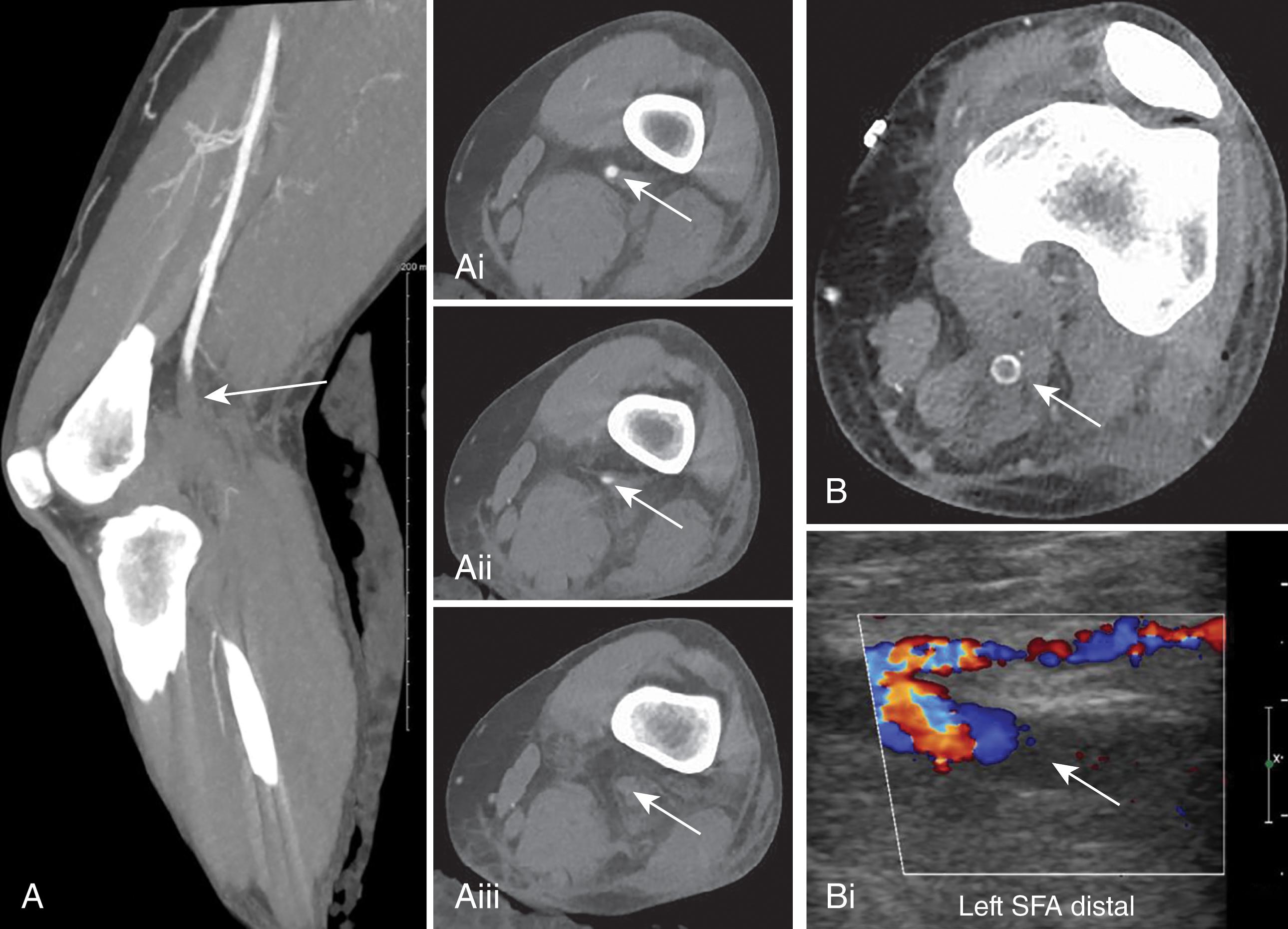
Delayed vascular injuries may occur following blunt and penetrating trauma and result in vessel outflow occlusion and low-flow symptoms or bleeding affecting adjacent structures. The most common vessel injuries are pseudoaneurysm formation, vessel dissections, and arteriovenous fistula. These occur in peripheral locations (upper and lower extremities) and aortic chest and abdomen branch injuries ( Fig. 2 ).
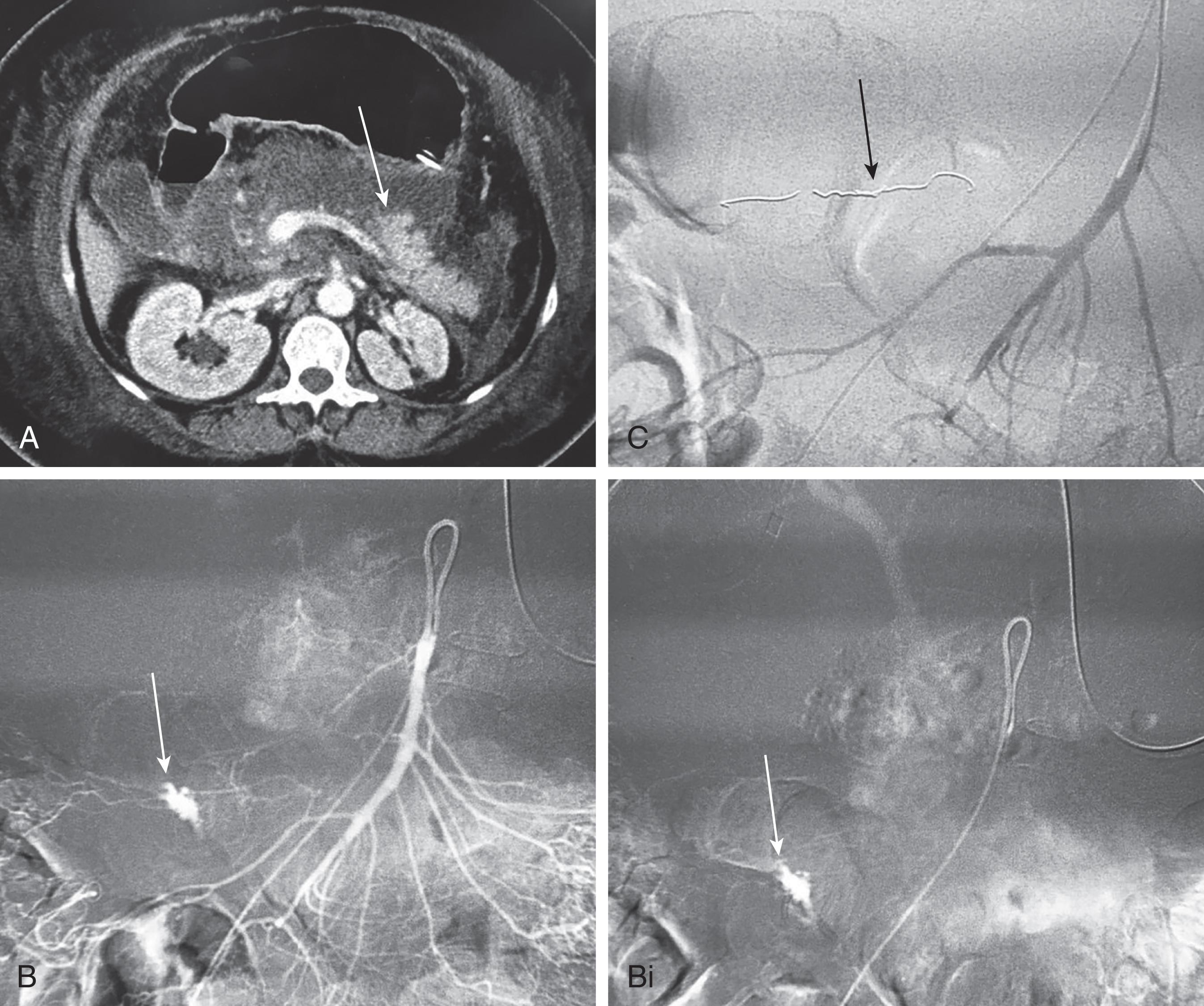
Delayed onset pseudoaneurysms (PSAs), also called false aneurysms because of a lack of regular vessel layers containing blood flow (intima, media, and visceral), may occur after traumatic events. PSAs may be inapparent initially and without clinical symptoms due to smaller size and not seen on initial cross-sectional imaging or develop following surgical interventions. PSAs enlarge due to a thin fibrous-type wall and increased tension from inflow blood pressure and may rupture due to the law of LaPlace, whereby wall stress increases as the aneurysm wall radius increases ( Fig. 3 ).
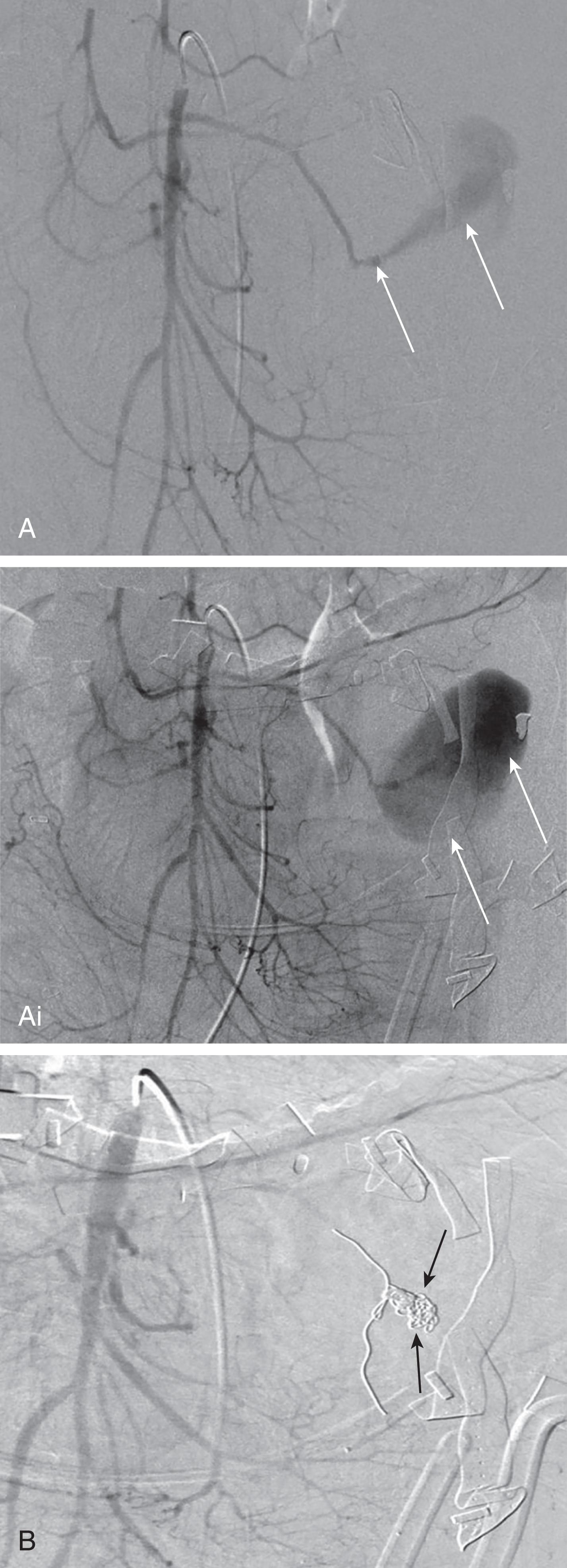
Both arteries and veins are affected by traumatic injury. However, the clinical significance in the subacute trauma phase occurs with arterial PSA growth, hemorrhage, and mass effect with hematoma formation. The aneurysm sac is frequently outlined by contained or extravasated contrast on cross-sectional imaging and during angiography.
Surgical exploration is performed for acute vascular injuries to the bowel to repair viscus perforation, intestinal nonviability, and vascular injuries. Transarterial catheter embolization is useful in situations where embolization benefits outweigh the risks, such as poor surgical candidates or an isolated mesenteric lesion in an otherwise stable patient, and to avoid risks of repeat surgery. Few trauma case reports have described successful, safe, and minimally invasive treatment for superior mesenteric artery PSAs. Kim et al. reported endovascular covered stent treatment of six superior mesenteric artery PSAs, with 3/6 trauma-induced, showing technical success in each, with maintained distal branch flow and no bowel ischemia over a 21-month mean follow-up period. Percutaneous coil embolization of PSAs has shown high success rates; however, if unsuccessful, the coils offer the surgeon a fluoroscopic marker for vessel territory exploration and repair.
Percutaneous CT and ultrasound-guided direct needle puncture of mesenteric PSAs with image-guided injection of thrombin, N -butyl cyanoacrylates, or other agents has been described with success for challenging to access PSAs. Direct puncture methods are frequently used for PSA treatment following common femoral artery vascular access; however, they can be utilized if transcatheter embolization fails. Challenges are nonaccess of the feeding branches of the PSA because of unfavorable anatomy, poor surgical candidates, and PSAs with multiple arterial inflow vessels. Close clinical follow-up is necessary to evaluate the risk of bowel ischemia and recurrent bleeding following direct puncture techniques. Reperfusion from collateral blood circulation refilling the PSA, infection, and coil migration all may cause recurrent symptoms and require reembolization.
Frostbite injuries are most common in cold-weather regions of the world and are often admitted to trauma services for wound and soft tissue management and care for associated blunt trauma injuries. During severe cold exposure, there is a physiologic reduction of peripheral blood flow to protect internal organs, typically in the fingers, toes, and nose. Vascular stasis and ischemia develop and cause a range of tissue changes from mild erythema to firm and insensate tissue. Interventional management involves catheter-directed tissue plasminogen activator (tPA) thrombolysis directed into the distalmost arteries of the affected extremity. Intra-arterial nitroglycerine is injected during the procedure to induce vasodilation during baseline angiography. Intra-arterial infusion is often combined with intravenous heparin and aspirin. Serial angiography assesses blood flow response in conjunction with the clinical status of the digits. Additional adjunctive therapies include hyperbaric oxygen treatment, sympathectomy, heparin alone, reserpine, and prostacyclins ( Fig. 4 ).
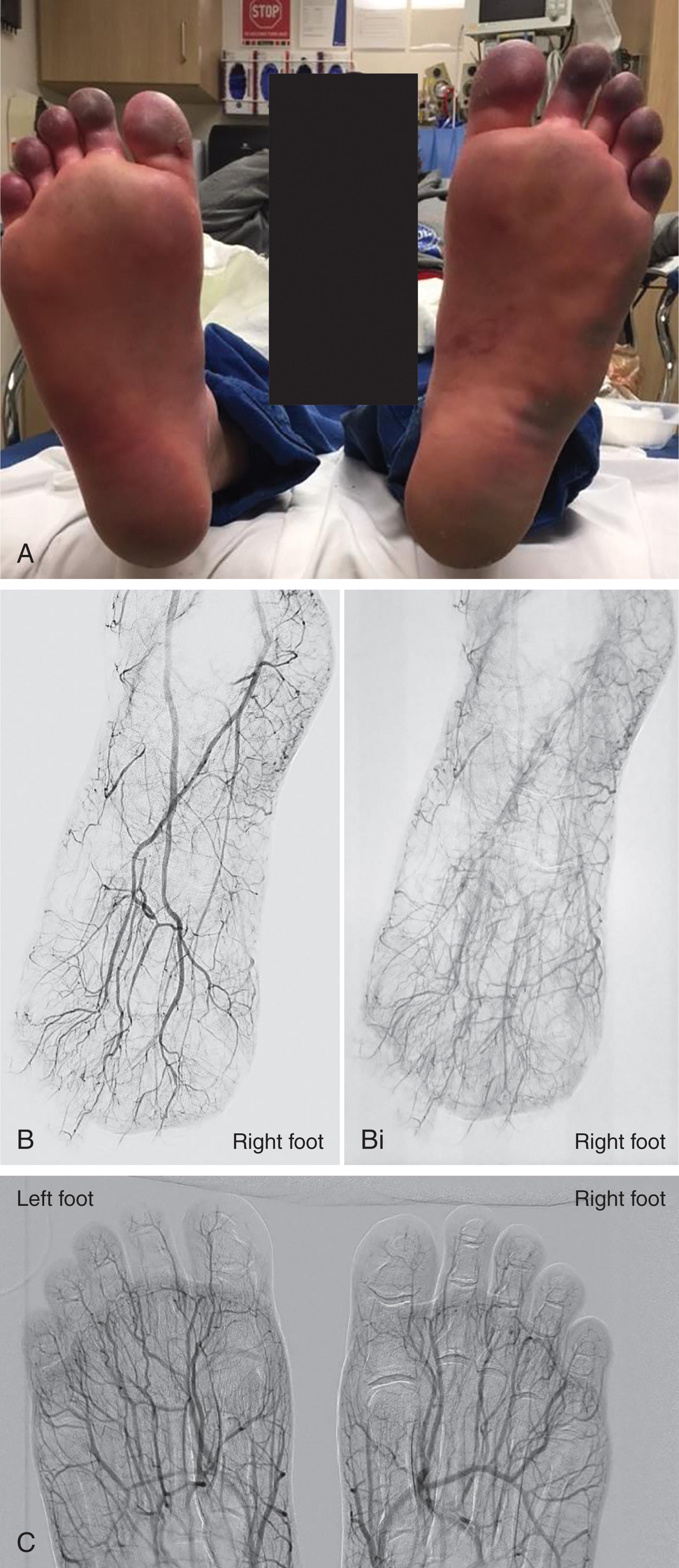
Trauma patients are at high risk for VTE events in lower extremity deep venous thrombosis (DVT), mesenteric venous occlusions, and pulmonary embolism (PE). A systematic review by Toker et al. found the incidence of VTE between 5% and 63% and dependent on risk factors that included the degree of pelvic and extremity fractures, neurovascular injuries, and immobilization. Other studies show the risk to be near 12%. The incidence of trauma-related thrombosis is mitigated by pharmacologic thromboprophylaxis, pneumatic sequential compression devices, and passive range-of-motion exercises.
Symptomatic DVT in the acute and subacute phase can be treated with CDT through venous access sites in the lower and upper extremities. CDT is particularly effective in the prevention of delayed postthrombotic syndrome leading to advance morbidity in high-risk populations. The ATTRACT trial interventional treatment arm reached equipoise with standard anticoagulation treatment with a potential for improvement in PTS with iliofemoral DVTs. Small-caliber catheters are placed via superficial upper or lower extremity veins and intravenous thrombolytics slowly infused over a 12- to 24-hour period with specialty multiple side hole infusion catheters. Ultrasound-generated acoustic wave-producing catheters are available and designed to accelerate lysis with clot agitation to increase surface area exposure. CDT for DVTs reduces time to thrombolysis and symptom improvement, decreases the amount of thrombolytic drug versus peripheral infusion methods, and lowers bleeding risks ( Fig. 5 ).
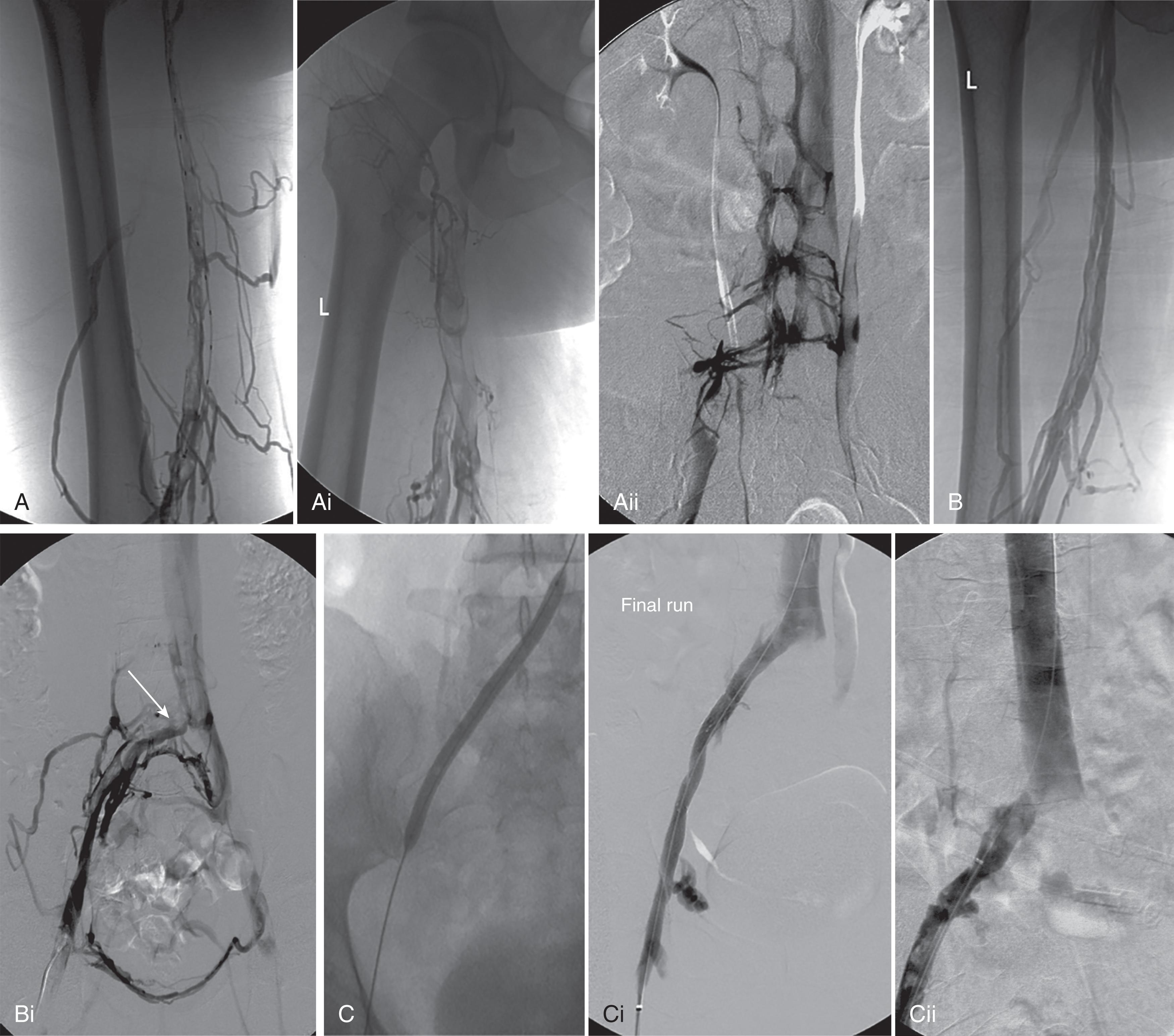
Become a Clinical Tree membership for Full access and enjoy Unlimited articles
If you are a member. Log in here